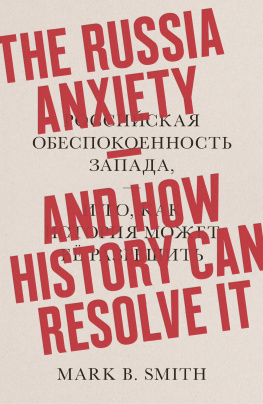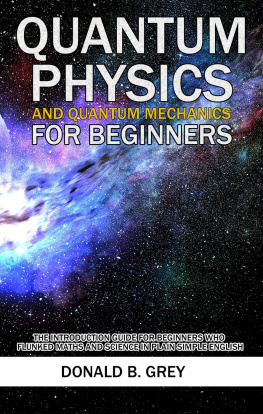Quantum Physics
for Beginners
Table of Contents
Copyright 2020 by _________. All right reserved.
The work contained herein has been produced with the intent to provide relevant knowledge and information on the topic on the topic described in the title for entertainment purposes only. While the author has gone to every extent to furnish up to date and true information, no claims can be made as to its accuracy or validity as the author has made no claims to be an expert on this topic. Notwithstanding, the reader is asked to do their own research and consult any subject matter experts they deem necessary to ensure the quality and accuracy of the material presented herein.
This statement is legally binding as deemed by the Committee of Publishers Association and the American Bar Association for the territory of the United States. Other jurisdictions may apply their own legal statutes. Any reproduction, transmission, or copying of this material contained in this work without the express written consent of the copyright holder shall be deemed as a copyright violation as per the current legislation in force on the date of publishing and subsequent time thereafter. All additional works derived from this material may be claimed by the holder of this copyright.
The data, depictions, events, descriptions, and all other information forthwith are considered to be true, fair, and accurate unless the work is expressly described as a work of fiction. Regardless of the nature of this work, the Publisher is exempt from any responsibility of actions taken by the reader in conjunction with this work. The Publisher acknowledges that the reader acts of their own accord and releases the author and Publisher of any responsibility for the observance of tips, advice, counsel, strategies, and techniques that may be offered in this volume.
Introduction
Welcome to Quantum Physics for Beginners ! Just the phrase quantum physics can strike fear into the heart of the most science-savvy, but this book is here to demystify the basic principles that form the fundamentals of quantum physics and give you a firm understanding from which you can continue to grow your knowledge.
Although you may not think about it, you use quantum physics daily. Every time you flick on a lightbulb or get in your vehicle to drive somewhere, quantum physics played a role in bringing you that technology. Simply put, quantum physics is the study of how the tiniest pieces of our universe work and interact. The field attracts the brightest minds in both science and mathematics, who have collectively spent the better part of the last century finding new ways to describe, explain, and manipulate atoms and molecules.
The impact of quantum physics on the modern world is not to be ignored. Without quantum physics, space travel and exploration would be impossible. The satellites that orbit the Earth would never have been built. We wouldnt have the advanced medical diagnostic equipment that so many health care providers depend on for imaging and treatment. The computer chips that power our cell phones, the coolant that runs through our refrigerators and air conditioners, and the burning of the sun itself are all powered by quantum physics.
Quantum Physics for Beginners will help you learn the history behind the science, including Bohrs earliest models of the atom and how others used his work to build their own theorems. Well take a look at the relationship between Bohrs model and the de Broglie equation and the advancement of particle and wave theory brought about by this development. Moving forward from these original hypotheses, well enter into a discussion about one of quantum physics underlying rules, the Planck Constant, and its counterpart, the Heisenberg Uncertainty Principle.
The book will finish up with an in-depth examination of the work of perhaps the worlds most famous physicist, Albert Einstein. Einsteins theorems and subsequent equations formed the basis of modern quantum physics; he brought together and coalesced the building blocks of study that are used today and will be used well into the future. Einsteins seminal works, including his Theory of Relativity, are the basis for nearly all quantum physics study and advancement in the 21 st century. Einstein was able to take the knowledge accumulated by others before him, create theories that tied together early principles, a bridge the knowledge gap between the history and the future of quantum physics.
Quantum Physics for Beginners aims to give you some fundamental insight into the fantastic world of science and math that rules how the universe works. With easy-to-read explanations and definitions, this book will break down the equations and the history behind them, and take a look at the extraordinary men who discovered the universes smallest fragments and attempted to harness them for science. If youre ready to dive into the world of quantum physics, lets get started. The wonders of the universe await you- lets go!
Chapter 1: What is Quantum Physics?
The study of quantum physics is one of sciences newer disciplines, but it has its roots in centuries of accumulated knowledge. Physics itself is a broad scientific field, encompassing the study of nature, matter, and energy. It includes research and analysis of how all matter acts and reacts, such as through light, sound, kinetic energy, magnetism, and the behavior of the atom. Quantum physics seeks to answer questions about matter and energy on its smallest, most fundamental levels and broadest, most universal levels. Looking at the history of the factors at play in modern quantum physics gives insight into how these concepts shape the field of study we see today.
Quantum physics grew from the humble beginnings of classical physics, which has been studied since the Sumerians first put chisel to tablet. The simple machines that we all learned about in grade school are examples of classical physics in action. And were sure that everyones heard the story of Archimedes discovering volume and displacement in his ancient Grecian bathtub. The truth is, physics is all around us, all the time. Gravity is whats keeping you from floating away right now. Physics keep your car running and on the road, and your headlights illuminating your way. Without physics, we wouldnt be able to enjoy the lifestyle that we do in the modern age. Since were here to talk about quantum physics, lets get things started with a look at the origins of the discipline, beginning with the first atomic theory.
The Grandfather of Atomic Study
Its the atom itself that forms the basis for the specialized field of quantum physics. Although the atom was first described in 400 B.C. by a Greek philosopher named Democritus, it wasnt until 1803 that the first scientific atomic theory was developed by British chemist John Dalton. Dalton was a pioneer in predictive meteorology and the study of genetic color blindness before moving onto atomic chemistry. He released a theorem in 1808, which detailed what he considered to be the five properties of the atom.
1- Atoms cannot be destroyed or divided
2- All the atoms in a single element are identical
3- Atoms of different elements have different properties and weights
4- The atoms of different elements can be combined in simple numbers to form molecules (Dalton used the word compounds)
5- Atoms can be neither created nor destroyed; all matter will break down in recoverable, unchanged atoms
Using these principles, Dalton would also create the first rudimentary periodic table. It contained only six elements- hydrogen, oxygen, nitrogen, carbon, sulfur, and phosphorus- but showed the relative weights of an atom of each element based on hydrogen having a value of one (1). Dalton gave the scientific community a firm basis on which to build the field we now know as quantum physics. In fact, very little has changed in the over two centuries since Dalton first published his atomic theory in a booklet called A New System of Chemical Philosophy. The only significant edit in his theory in the two-plus centuries since its publication is that we now know that the atom is not the smallest unit of matter; an atoms individual components can also be seen and measured. We also now know that an atom can be split, and we have the technology to do so.








